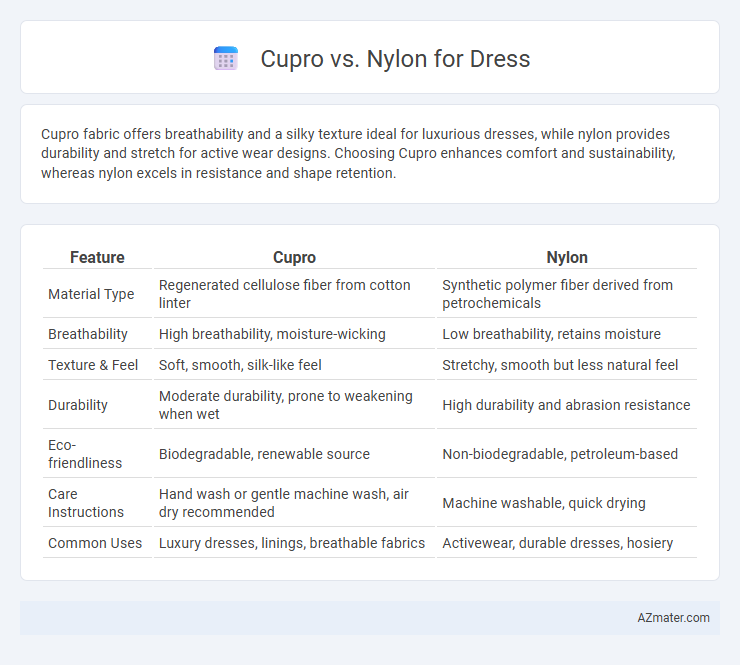Cupro fabric offers breathability and a silky texture ideal for luxurious dresses, while nylon provides durability and stretch for active wear designs. Choosing Cupro enhances comfort and sustainability, whereas nylon excels in resistance and shape retention.
Table of Comparison
| Feature | Cupro | Nylon |
|---|---|---|
| Material Type | Regenerated cellulose fiber from cotton linter | Synthetic polymer fiber derived from petrochemicals |
| Breathability | High breathability, moisture-wicking | Low breathability, retains moisture |
| Texture & Feel | Soft, smooth, silk-like feel | Stretchy, smooth but less natural feel |
| Durability | Moderate durability, prone to weakening when wet | High durability and abrasion resistance |
| Eco-friendliness | Biodegradable, renewable source | Non-biodegradable, petroleum-based |
| Care Instructions | Hand wash or gentle machine wash, air dry recommended | Machine washable, quick drying |
| Common Uses | Luxury dresses, linings, breathable fabrics | Activewear, durable dresses, hosiery |
Introduction to Cupro and Nylon
Cupro, a regenerated cellulose fiber derived from cotton linter, offers breathability, a silky texture, and excellent moisture absorption, making it ideal for comfortable, high-end dresses. Nylon, a synthetic polymer fiber known for its strength, elasticity, and durability, provides wrinkle resistance and a lightweight feel, commonly used in form-fitting or performance fabrics. Both materials serve distinct purposes in dressmaking, with Cupro emphasizing natural comfort and Nylon focusing on resilience and stretch.
Key Differences Between Cupro and Nylon
Cupro is a regenerated cellulose fiber made from cotton linter, known for its breathability, moisture-wicking properties, and silky texture, making it ideal for comfortable, luxurious dresses. Nylon, a synthetic polymer, is valued for its high durability, elasticity, and resistance to wrinkles and abrasions, offering strong performance in activewear and form-fitting dresses. While Cupro excels in natural feel and biodegradability, Nylon outperforms in stretch and resilience, influencing dress design based on sustainability and wear requirements.
Fabric Origins: How Cupro and Nylon Are Made
Cupro is a regenerated cellulose fiber derived from cotton linter, a byproduct of cotton production, involving a chemical process that dissolves the cellulose into a silky, breathable fabric. Nylon, a synthetic polymer made from petrochemicals through a polymerization process, results in a durable and elastic fabric commonly used for dresses requiring stretch and resilience. Understanding the origins highlights Cupro's natural, biodegradable source and Nylon's synthetic, petroleum-based composition, influencing sustainability and wearability in dress fabrics.
Sustainability and Environmental Impact
Cupro is a sustainable fabric made from regenerated cellulose fibers derived from cotton linter, offering biodegradability and low environmental impact due to its closed-loop production process that recycles chemicals and water. Nylon, a synthetic polymer derived from petroleum, contributes significantly to environmental pollution through non-biodegradability and high greenhouse gas emissions during production. Choosing cupro over nylon for dresses reduces reliance on fossil fuels, minimizes microplastic pollution, and supports circular fashion practices, making it a more eco-friendly option in sustainable clothing.
Comfort and Feel: Wearing Experience
Cupro fabric offers a silky, breathable feel that mimics natural fibers, making it ideal for dresses worn in warm weather due to its moisture-wicking properties and soft hand. Nylon, in contrast, tends to feel smoother and more lightweight but can trap heat and moisture, potentially causing discomfort during prolonged wear. The wearing experience of Cupro is often described as cooler and more natural, while Nylon provides durability and stretch but may lack the breathable comfort of Cupro.
Durability and Longevity
Cupro fabric offers excellent durability due to its resilient cellulose fibers derived from cotton linter, providing a silky texture while resisting wear and tear better than many synthetic alternatives. Nylon, a strong synthetic polymer, boasts superior tensile strength and abrasion resistance, making it highly durable and long-lasting under frequent use. When comparing longevity, nylon typically outperforms cupro in endurance, maintaining structural integrity through multiple washes and extended wear, while cupro may show signs of fiber breakdown and pilling over time.
Care and Maintenance Requirements
Cupro dresses require gentle hand washing or dry cleaning to maintain fabric integrity and avoid shrinkage, making them less suitable for frequent washing. Nylon dresses offer durable, wrinkle-resistant properties and can be machine washed on a gentle cycle, providing easier maintenance and faster drying. Both fabrics benefit from low-heat ironing, but Cupro's delicate fiber structure demands more careful handling to preserve its smooth texture and sheen.
Style and Appearance in Dresses
Cupro offers a luxurious matte finish with a silky drape that enhances the elegance of dresses, lending a sophisticated yet breathable texture ideal for formal or flowy styles. Nylon, characterized by its smooth, shiny surface and excellent elasticity, is often used in body-hugging or performance dresses, providing a sleek and polished look with added durability. In terms of style, Cupro evokes a natural, refined aesthetic suited for classic and vintage-inspired designs, while Nylon supports modern, vibrant, and structured dress silhouettes.
Cost Comparison: Cupro vs Nylon
Cupro fabric generally costs more than nylon due to its eco-friendly production process and silky, breathable texture, which adds to the garment's overall price. Nylon is cheaper to manufacture, widely available, and known for its durability and stretch, making it a cost-effective option for dress materials. When choosing between cupro and nylon, budget considerations often favor nylon for affordability, while cupro offers a more premium, sustainable fabric choice.
Which Fabric Is Better for Dresses?
Cupro is a breathable, eco-friendly fabric made from regenerated cellulose fibers, offering a silky texture and excellent moisture-wicking properties ideal for comfortable, elegant dresses. Nylon is a synthetic fiber known for its durability, stretch, and resistance to wrinkles, making it suitable for form-fitting or activewear-style dresses but less breathable than Cupro. For dresses prioritizing comfort, breathability, and sustainability, Cupro is generally the better fabric, while Nylon excels in longevity and stretch.

Infographic: Cupro vs Nylon for Dress
 azmater.com
azmater.com